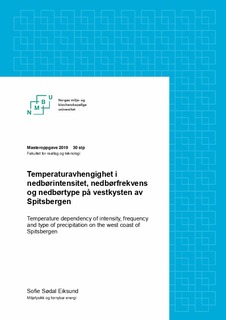| dc.contributor.advisor | Wolff, Mareile Astrid | |
| dc.contributor.advisor | Isaksen, Ketil | |
| dc.contributor.advisor | Dobler, Andreas | |
| dc.contributor.author | Eiksund, Sofie Sødal | |
| dc.coverage.spatial | Norway, Svalbard, Spitsbergen | nb_NO |
| dc.date.accessioned | 2019-08-19T08:36:51Z | |
| dc.date.available | 2019-08-19T08:36:51Z | |
| dc.date.issued | 2019 | |
| dc.identifier.uri | http://hdl.handle.net/11250/2608925 | |
| dc.description.abstract | Temperaturen på Svalbard har økt med 3-5 °C de siste 50 årene, øygruppen er blant de områdene på jorda som har den største temperaturøkningen i denne perioden. Denne oppgaven ser på temperaturavhengiget i nedbør, og om det har endret seg de siste 50 årene.
I denne oppgaven er temperaturavhengighet i nedbørintensitet, nedbørfrekvens, og nedbørtype undersøkt ved fire målestasjoner på vestkysten av Spitsbergen, Svalbard. Det er også undersøkt om det er endringer i disse mellom periodene 1974-1995 og 1995-2019.
Det kommer fram at samtidig som temperaturen har steget har nedbørfrekvens og nedbørintensitet også økt, og en større andel av nedbøren har falt som regn. Endringen i frekvens, intensitet og fordeling av nedbørtyper skyldes økende temperatur og ikke endringer i temperaturavhengigheten til nedbør. | nb_NO |
| dc.description.abstract | The temperature in Svalbard has increased by 3-5 °C during the last 50 years. The archipelago of Svalbard is among the areas in the world that have seen the largest increase in temperature during this period of time. This thesis studies the temperature dependency on precipitation, and whether that has changed in the last 50 years.
In this thesis the temperature dependency of intensity, frequency and type of precipitation is studied at four weatherstations at the west coast of Spitsbergen, Svalbard. One part of the analysis is to identify changes in temperature dependency of precipitation between the periods 1974-1995 and 1995-2019.
Results show that there has been an increase in intensity and frequency of precipitation in Svalbard, following the increase in temperature. There has also been a increase in the fraction of precipitation falling as rain. The changes to the frequency and intensity, and the increased fraction of liquid precipitation appears to be caused by the increasing temperature, and not by alterations in the temperature dependency of precipitation. | nb_NO |
| dc.language.iso | nob | nb_NO |
| dc.publisher | Norwegian University of Life Sciences, Ås | nb_NO |
| dc.rights | Attribution-NonCommercial-NoDerivatives 4.0 Internasjonal | * |
| dc.rights.uri | http://creativecommons.org/licenses/by-nc-nd/4.0/deed.no | * |
| dc.subject | Meteorologi | nb_NO |
| dc.subject | Klima | nb_NO |
| dc.subject | Nedbør | nb_NO |
| dc.subject | Temperatur | nb_NO |
| dc.subject | Svalbard | nb_NO |
| dc.title | Temperaturavhengighet i nedbørintensitet, nedbørfrekvens og nedbørtype på vestkysten av Spitsbergen | nb_NO |
| dc.title.alternative | Temperature dependency of intensity, frequency and type of precipitation on the west coast of Spitsbergen | nb_NO |
| dc.type | Master thesis | nb_NO |
| dc.subject.nsi | VDP::Matematikk og Naturvitenskap: 400::Geofag: 450::Meteorologi: 453 | nb_NO |
| dc.source.pagenumber | 100 | nb_NO |
| dc.description.localcode | M-MF | nb_NO |

